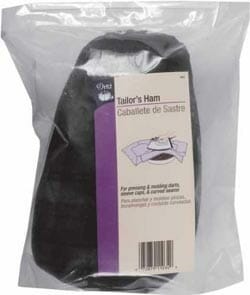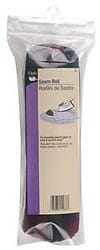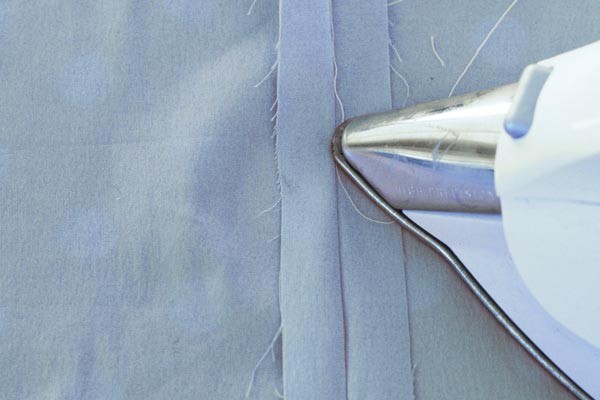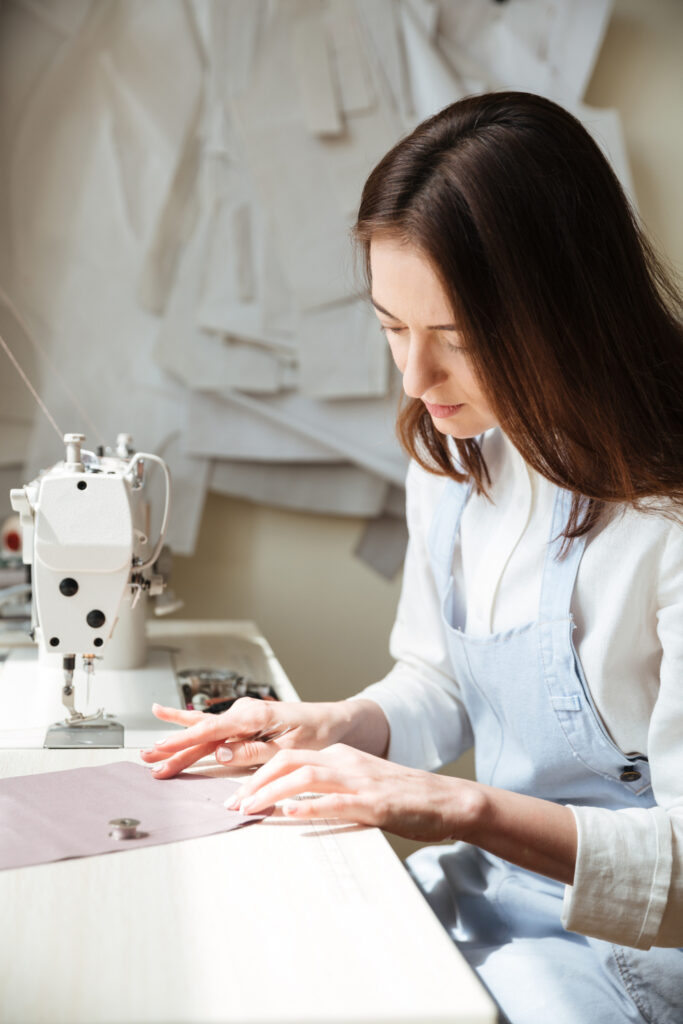Vous avez dû remarquer que la plupart des patrons de couture indiquent de presser les coutures tout au long des instructions.It may be as simple as the word Press, or there may be further instruction – press seams open, press dart down, press to one side. Do you always press as you sew? Is it really necessary? Is there a ‘correct’ way to do it? Let’s take a look.
Why press as we sew?
Sometimes there are a series of complicated construction steps involved in making a garment. Seams can be tricky to all press at the end so are better pressed in the order they are sewn. Often seams will meet or cross and if one seam isn’t correctly laid flat when it is over-sewn, it may be bulky or uncomfortable when worn or even cause puckering visible from the outside. And nothing shouts ‘home-made’ more than a garment that hasn’t been really well pressed during the sewing process.
Ancient/Internet sewing wisdom tells us that the ‘correct’ way to press our seams when sewing is a two step process.
- Press seam flat first, then
- press seam open.
Pressing flat is said to ‘set’ or ‘meld’ the stitches (really?) but of course it does tend (I think) to make them shrink up just a very tiny bit as you steam and makes the thread disappear into the fabric. It also smooths the fabric flat and removes any tiny puckers. Do I always do it? No, not always, but on a very precious fabric or a very special garment I certainly would. It doesn’t take a lot of extra time.
- So first press the seam flat to remove any little puckers.
- Then gently open the seam with your fingers and ‘finger press’ the seam open without pulling and stretching it.
- Encourage the seam to open by running your tip of the iron along the fabric with some steam and
- then follow up by pressing the seam fully open and flat.
- Press from the wrong side first, then turn the fabric and press from the right side.

Sewing pattern directions explained
Press as sewn – exactly as it says. Don’t open or flatten the seam, just press along the seam exactly as you have sewn it. This ‘sets’ the stitches into the fabric. Can remove any tiny puckers that might have occurred under the stitching line and can correct any slight tension issues.
Press seam open – start by pressing as sewn to remove tiny puckers and set your stitches. Then open the seam with your fingers, finger press, use the tip of your iron to start and then finish with the flat of your iron to press seams flat. Remember to ‘press’ the seam with an up and down motion, not iron it vigorously back and forth just to avoid any unwanted stretching.
Press to one side -more often using in quilting than garment sewing. Instead of pressing the seam open, press both sides of the seam to one side on the wrong side. If using two different fabrics, it is generally recommended to press to the side of the darker fabric to prevent show through from the front.
Pressing darts – darts should always be pressed before moving on to the next step. Your pattern instructions will usually tell you in which direction to press your darts, but there are also general guidelines that horizontal darts such as bust darts should be pressed down and vertical darts should be pressed towards the center. Always start at the broad end of the dart and press towards the point and do be aware that darts are added to fabric to give it shaping, so allow your iron to shape the fabric as you press. The use of a pressing ham is useful to get the fabric to curve to the shape of your body.
Use of a pressing cloth
Use a finely woven cotton, or silk organza makes a lovely Press Cloth and has the benefit that you can see through to the garment underneath. Any fabric that can take a high heat may be suitable. Needless to say it should always be clean so don’t let it fall off the ironing board onto the floor where your muddy cat can sleep on it (oops).
Why use a press cloth?
- Some fabrics can develop a shine when you press them. Especially wool and suiting fabrics.
- Protects fabric from any scale, spitting or deposits from your iron.
- Prevents the iron sticking to your fabric.
- Will provide some protection to the fabric if you inadvertently set the iron to high and start to iron before you notice.
Other pressing tools
 Pressing Ham – will usually have one side on cotton and one side in wool. Its shape provides all sorts and sizes of curves which you can use for pressing curved seams such as over darts, shoulders and sleeve caps, princess seams, hips on skirts and dresses. If you bind curved seam edges such as necklines and arm holes, then pressing these bound curves over a ham also creates a very smooth finish.
Pressing Ham – will usually have one side on cotton and one side in wool. Its shape provides all sorts and sizes of curves which you can use for pressing curved seams such as over darts, shoulders and sleeve caps, princess seams, hips on skirts and dresses. If you bind curved seam edges such as necklines and arm holes, then pressing these bound curves over a ham also creates a very smooth finish.
 Sleeve roll – not just for sleeves! Push up inside your sleeve as you press to prevent unwanted creases and also use to press regular seams open on delicate or thin fabrics to prevent show through on the right side. Also good for skinny pants legs and any small curved seams, shoulders, sleeve caps, cuffs and gathers.
Sleeve roll – not just for sleeves! Push up inside your sleeve as you press to prevent unwanted creases and also use to press regular seams open on delicate or thin fabrics to prevent show through on the right side. Also good for skinny pants legs and any small curved seams, shoulders, sleeve caps, cuffs and gathers.
My pressing tips –
- never sew over an unpressed seam.
- use a sleeve roll to press without leaving impressions of the underlying fabric edge
- when pressing knits or delicate fabrics, press up and down rather than side to side to avoid stretching
- always press in the direction of the grain
- pay attention to pattern instructions – should you press a seam open or to one side?
- press on both sides, wrong side first, then the right side
- your iron doesn’t just make things flat, you can use it to mold curves too
- always use plenty of heat and steam if your fabric allows
- you can also use a piece of thin card as a pressing tool to prevent show through of the seam edge onto the right side, especially with thick seams or heavy fabrics – example here

I have lines drawn on the edges of my pressing card at half inch, one inch and 5/8th of an inch as this helps me press a nice neat and even seam for hemlines etc.
Do you have any favorite pressing tools or tips? What do you think about the two step seam press – do you press flat first or is the whole ‘melding stitches’ a bit too far-fetched for you?
Si presser une couture est très important, il y a différentes manières de procéder car on peut avoir à repasser une couture
Parfois, pour certains ouvrages compliqués, on doit coudre une série de couture les unes après les autres. Les coutures peuvent être difficile à presser à la fin et il vaut mieux les presser dès qu’elles sont piquées. Sometimes there are a series of complicated construction steps involved in making a garment. Seams can be tricky to all press at the end so are better pressed in the order they are sewn. Often seams will meet or cross and if one seam isn’t correctly laid flat when it is over-sewn, it may be bulky or uncomfortable when worn or even cause puckering visible from the outside. And nothing shouts ‘home-made’ more than a garment that hasn’t been really well pressed during the sewing process. Ancient/Internet sewing wisdom tells us that the ‘correct’ way to press our seams when sewing is a two step process.

Presser vs repasser
Quand on coud une couture, on va presser le tissu et non le repasser. Il est important de connaître la différence puisque lorsque l’on coud, on est amené à ouvrir les coutures
Repasser, comme son nom l’indique, a pour principe de faire glisser sur le tissu dans un sens puis dans l’autre. Ainsi, après avoir lavé un vêtement, on enlève les plis, on le défroisse en le repassant.
A l’inverse, presser signifie qu’on pose le fer à repasser sur le tissu, qu’on appuie légèrement et qu’on soulève le fer pour le poser à un autre endroit du tissu. Ce faisant, on ne fait pas glisser le fer sur le tissu et on évite ainsi d’étirer ce dernier et de le déformer. Or, étirer ou déformer le tissu est plutôt mauvais quand on confectionne un ouvrage ! Il vaut donc mieux presser les plis pour les éliminer que repasser le tissu. Ou quand on ouvre une couture ou qu’on couche une pince.
Presser peut également signifier qu’on tient le fer à repasser par dessus le tissu pour projeter de la vapeur sur le tissu et ainsi le défroisser (ce que font les pressings).
Presser permet non seulement de fixer les points dans le tissu mais cela va également lisser les coutures (en particulier dans les courbes) et le rendu n’en sera que meilleur. Il est également important de presser les pinces, les plis et de presser dans le bon sens.
Les outils pour presser les coutures
If your seams are bulky, try pressing them open, rather than to one side. If you are sewing denim, wool, canvas, or another thick material, you can use a tailor’s clapper to help reduce bulk. Read more about pressing tools in this article by David Page Coffin.
comment presser les coutures?
Assembler un vêtement ou un accessoire se fait en plusieurs temps. Il est bien plus facile de presser les coutures au fur et à mesure qu’en une seule fois à la fin. D’autre part, quand deux coutures se croisent, il vaut mieux que la première ait été repassée pour pouvoir piquer plus facilement et que cela ne se Découvrez les astuces pour bien repasser.
Régler la température du fer en fonction du tissu. Repasser la couture telle quelle, en pressant sur le côté du fil de la bobine : il sera plus facile d’ouvrir la couture, le résultat sera plus net et vous ne vous brûlerez plus les doigts.
Ouvrir et repasser doucement avec la pointe du fer sur l’endroit.
Retourner et presser avec le fer le long de la couture.
Retourner une dernière fois et repasser jusqu’à ne presque plus sentir la couture. Il faut presser le fer, et non pas le faire glisser, sur la couture.


